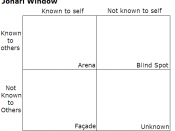THE JOHHARI WINDOW- Solving Sport Management Communication Problems
"We keep hearing that sport leaders need to improve communication skills, and techniques like listening skills improvement, or how to write or speak more clearly, are prescribed" (p.49). This is the leading reason Joseph Luft and Harry Ingram got together to develop something they call the Johari window.
The Johari window is a representation that reflects four windows of interpersonal actions between one and others. The name comes from the first names of each man who created it, Joseph Luft and Harry Ingram. "Cell I refers to information mutually known by both you and the employee or player. It is called the 'area' since it is an area in which you can both play. Cell II represents information known by the employee or player, but not you. It is aptly called the 'blind spot.' Cell III represents information known to you, but not others.
Since you are shielding others from this information, it is called the 'façade.' Cell IV represents information unknown by either party. It is referred to as the 'unknown' by the model's creators, or 'death valley' by the author. Obviously, the more leader and follower share information the greater the interpersonal understanding, and there fore, less communication" (p.49).
With the results from the four cells, four basic interpersonal styles emerged. Type A is not what you would call a people person. He does his best on his own, mainly found in an office. Type B is the kind of person who sits back and watches. He takes in all the information given but never hands out any information of his own. Type C is a very strict professional. He is never wrong in his eyes and doesn't take well to others suggestions. Type D is someone who...


